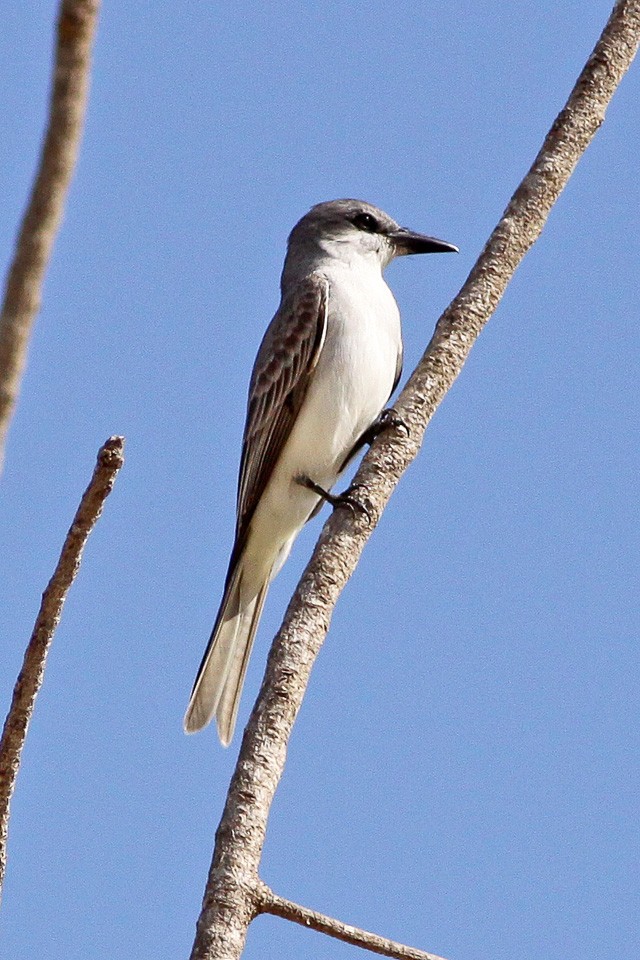Grey Kingbird
A species of Kingbirds, Also known as Gray Tyrant Scientific name : Tyrannus dominicensis Genus : Kingbirds
Grey Kingbird, A species of Kingbirds
Also known as:
Gray Tyrant
Botanical name: Tyrannus dominicensis
Genus: Kingbirds
Content
Description General Info
Description
The grey Kingbird is known for its long beak and loud calls. This species has developed large populations in Florida where it can be found in marsh and savanna ecosystems. The grey Kingbird likes to sit on tall, exposed perches in order to watch for insects, lizards, and any potential threats to its territory.
Size
23 cm (9 in)
Colors
Brown
Black
Gray
White
Nest Placement
Tree
Clutch Size
3 - 4 eggs
Incubation Period
1 brood
Number of Broods
14 days
Nestling Period
16 - 18 days
Feeding Habits
Grey Kingbird primarily consume flying insects captured in mid-air through agile, swift flights and complex maneuvers. They also glean insects from various surfaces and consume small lizards, occasionally hummingbirds and minnows. They strip larger prey like insects of wings and lizards of skin before eating, and eat small fruits, which they may hover or perch to pluck. Their diet includes beetles, bees, wasps, dragonflies, butterflies, moths, flies, and larvae, along with fruits from specific plants.
Habitat
Grey Kingbird's favored habitats encompass open and semi-open areas, often near water and coastal zones, thriving from sea level to modest altitudes. They inhabit diverse vegetation ranging from pine woods to native forest fringes, readily adapting to human-altered environments, including agricultural and residential areas. These birds winter across Caribbean coastal lowlands to urban and grassland settings.
Nest Behavior
Construction of the nest is undertaken by the female grey Kingbird, who may lay her eggs soon after the nest is completed. Eggs are typically incubated by both parents, who also share responsibilities in feeding and protecting the young once hatched. The grey Kingbird exhibits strong territorial behavior during the nesting period to safeguard its offspring.
Nest Characteristics
The nest of grey Kingbird is typically located at a height of about 10 feet in a tree fork or on a horizontal limb, often above water. It is a roughly constructed cup-shaped structure that measures approximately 9.5 inches in width and 2.8 inches in height, with the interior cup being about 3.4 inches wide and 1.4 inches deep. The nest is made from twigs, stems, and grasses, and may be lined with softer materials like moss, hair, and rootlets.
Dite type
Insectivorous
General Info
Feeding Habits
Bird food type
Behavior
Throughout the day, grey Kingbird exhibits a mix of territorial, collaborative, and social behaviors. With dawn, males stake out and defend territories, signaling ownership through vocal calls and prominent flights. This species quickly forms pairs, engaging in synchronized flight displays to strengthen their bond. These displays are characteristically vibrant, with bill snapping and loud calls as they ascend. At the nest site, pairs reinforce their bond with fluttering wing greetings. Although grey Kingbird may seem bold in demeanor, they show surprising tolerance towards conspecifics, barring occasional territorial chases or aggressive crested displays flaunting their hidden scarlet crown feathers. They are vigilant in protecting their breeding spaces from cowbirds, suggesting a high level of parental investment. When constructing nests, the division of labor is pronounced; both sexes collect materials, but females lead in site selection and construction while males stand guard. Egg incubation is primarily a female's task, but males may contribute. Post-hatching, chick rearing is a shared responsibility. As breeding season concludes, grey Kingbird forms small flocks in preparation for migration. In their winter habitats, they typically congregate in large groups within mangroves, their evening cacophony marking the nightly ritual before roosting commences.
Distribution Area
It is found in increasing numbers in the state of Florida, and is more often found inland though it had been previously restricted to the coast. The species was first described on the island of Hispaniola, then called Santo Domingo, thus the dominicensis name. It breeds from the extreme southeast of the United States, mainly in Florida, through Central America, through the West Indies, south to Venezuela, Trinidad, Tobago, the Guiana, and Colombia. Northern populations are migratory, wintering on the Caribbean coast of Central America and northern South America. Several vagrant populations are known to exist in the American Northeast. 
Species Status
Not globally threatened.
Scientific Classification
Phylum
Chordates Class
Birds Order
Perching birds Family
Tyrant flycatchers Genus
Kingbirds Species
Grey Kingbird 